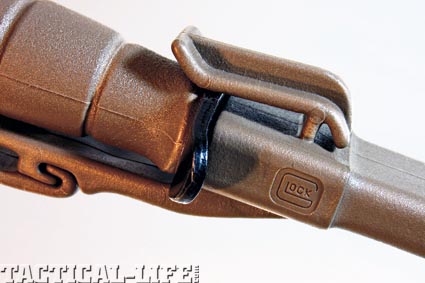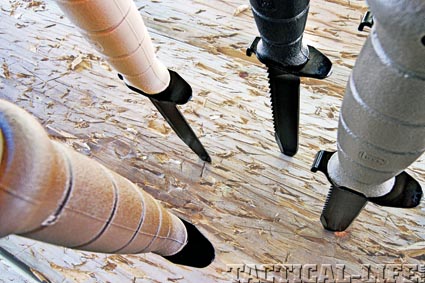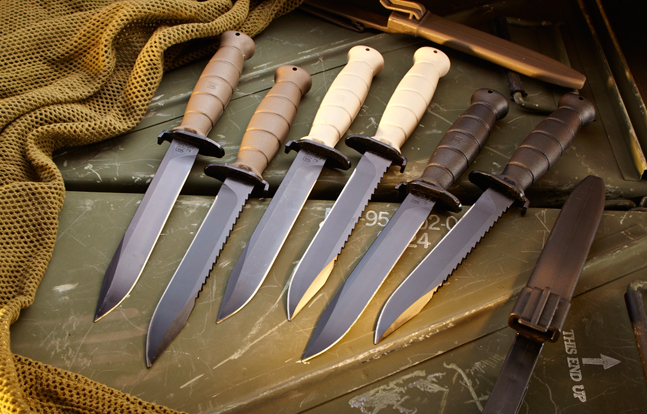Produced with input from the Austrian army, Glock’s steel and polymer survival knives are rugged and dependable—not unlike their other world-famous defensive products. Steve Woods Photos
Beyond designing and manufacturing pistols of legendary ruggedness and durability used by military and police forces all over the world, Glock also designs and manufactures two knives: the Glock Field Knife 78 and Survival Knife 81. Produced with input from the Austrian Army, the Glock knives—not surprisingly—bear a remarkable resemblance to their pistol cousins. Both the Field Knife 78 and Survival Knife 81 are comprised of carbon-steel blades and polymer handles—the same durable polymer that Glock offers in its 21 pistol models. The only difference between the Field Knife 78 and Survival Knife 81 is that the blade of the Survival Knife 81 comes with a saw back and weighs just few ounces less than the Field Knife 78. Other than that, both knives are physically identical, and both come with a super-tough yet very functional polymer sheath. These tools are profoundly simple and engineered for ruggedness and usefulness.
Cutting-Edge Design
Advertisement — Continue Reading Below
The Field Knife 78 and Survival Knife 81 both feature 6.5-inch carbon-steel, clip-point blades. A clip-point blade, similar to a drop-point blade, has a “false edge” toward the point opposite the blade. As such, the blade tapers to a point, making it more capable of piercing. Carbon steel is one of the hardest steels, and therefore one of the strongest and most durable. Sometimes carbon steel is referred to as “spring steel,” as its properties allow it to flex under abusive conditions and yet retain its shape, strength and functionality. The blade, 0.19 inches wide, is also coated in black phosphate, which helps protect it against corrosion and reduces glare, decreasing the potential for giving away the user’s position to an enemy.

The sheath’s most unique design feature is the reinforced, flexible retention tab that securely holds the knife in place, regardless of whether the knife is inserted with the blade to the front or back.
The back of the Field Knife 78 blade is straight and flat. The back of the Survival Knife 81 bears a 4-inch saw—alternating sharp ridges and points that will shred and tear whatever it is applied to. Glock knives come with a factory edge that is razor sharp. Their functionality, however, goes well beyond just cutting. These are robust tools that can and have been used to hack, split, chisel and pry.
Advertisement — Continue Reading Below
Separating the blade and the handle is a carbon-steel crossguard. One side of the crossguard extends 0.75 inches below the blade, offering protection for a user’s hand. The other side of the crossguard extends 0.44 inches above the blade and curves toward the front of the blade, offering a mechanism for prying. With its strong construction and the leverage afforded by its location between the blade and handle, the crossguard pry is a formidable tool, able to handle the most demanding jobs—from prying supply cans open to bending metal. Its most popular use, however, might be the noble task of opening bottles.
Made of the same polymer found in its pistols, the handles of the Glock Field Knife 78 and Survival Knife 81 are 4.75 inches in length. The rounded handles vary in circumference from front to back, but the widest point in the middle measures 3.63 inches. All Glock knives have opposing indentations in the handle near the crossguard to accommodate the sheath’s retention tab, no matter which way it is inserted into the sheath. In addition, the polymer of the handle is textured and offers five indented rings to aid in purchase. The ends of each handle also provide two opposing 0.16-inch holes, perhaps for affixing a ring as a means of attaching a lanyard or, a user can drill through the holes using a 0.16-inch drill bit to allow for a lanyard to pass right through the handle. The end of the handle features a plastic plug, which, when removed, reveals a 1.5-inch-deep metal socket with the same previously mentioned holes machined into it. While the plastic plug is very durable, it could only take limited abuse such as that caused by using it as a pommel or hitting it with a hammer when using the knife as a chisel. Of interest, the metal socket and the forward-curved portion of the crossguard could work in conjunction so that the knife could serve as a bayonet on an assault rifle.

Made of the same polymer found in its pistols, the handles of the Glock Field Knife 78 and Survival Knife 81 are 4.75 inches in length.
Advertisement — Continue Reading Below
Sheath Specs
Both knives use the same sheath, a one-piece polymer product that measures almost 11 inches in length and weighs 1.5 ounces. The ambidextrous sheath’s most unique design feature is the reinforced, flexible retention tab that securely holds a Glock knife in place, regardless of whether the knife is inserted with the blade to the front or back. Once a Glock knife is inserted all the way into the sheath, the crossguard pushes the retention tab out until it automatically closes over the edge of the crossguard, snapping in place. To release the knife from the sheath, a user has to push the retention tab away with a thumb. It is possible to deploy the knife from the sheath using one hand. All of this occurs in a one-piece polymer sheath because of thoughtful design.
The sheath also offers a belt loop with a useful design that allows a user to easily but securely attach it to a belt up to 2.5 inches wide and up to 0.19 inches thick. Inside the top of the belt loop, a polymer protrusion reinforces the belt loop at its stress point and reduces the belt loop’s width to an eighth of an inch to prevent the sheath from sliding when worn on a belt. If a user doesn’t have a belt, the sheath can be attached to pants or shorts by simply clipping the sheath to the waistband.
Advertisement — Continue Reading Below
In addition to the retention tab and belt loop, the sheath offers a lanyard hole for lashing the point end of the sheath. For example, when the sheath is worn on a belt, a lanyard can be tied through the loop to the user’s thigh. The sheath also offers a drainage hole near the tip (or point).
Field Survival
Both Glock knives are 11.38 inches in length. While all Glock knives have blades that are coated in black phosphate, the handles and sheaths come in three colors: midnight black (to blend with tactical gear used in urban environments), olive drab (to blend with camouflage or equipment used in woodland or jungle environments), and sand (to blend with camouflage or equipment used in desert environments). Besides one having a saw blade back and the other having a plain back, the only differences between the Glock Field Knife 78 and Survival Knife 81 are in the knives’ weight and price. The Glock Field Knife 78 weighs 7.3 ounces and retails for $30. The Glock Survival Knife 81 weighs 7.0 ounces and retails for $32. The difference in weight and cost comes from the additional manufacturing required to create the saw blade on the back of the Survival Knife 81.
Advertisement — Continue Reading Below

The Survival Knife 81 features a saw blade positioned on the back edge, while the Field Knife 78 offers a straight edge.
The relatively low retail prices reflect Glock’s economic savvy along with an understanding of real-life conditions for soldiers, law enforcement and civilian users. At only $30 or $32 per knife, a user can afford to purchase more than one and won’t suffer an economic setback should he or she lose one. Further, whereas a user might shy away from pushing a more expensive knife to its extreme usefulness, the user of a Glock knife can push it to the extreme—mainly because it’s a rugged tool made by Glock and secondarily because it is available at a fraction of the cost of other knives that may not even be up to the kinds of tasks a Glock knife will face.
Every Glock knife blade bears the phrase “Made in Austria,” along with the Glock logo and the knife’s model number near the crossguard. With two variants to choose from in three different colors, users can select one or more of the six models that will best meet their needs. Whether you’re a first-time buyer of a Glock product or a long-time Glock pistol user, the Glock knives are indispensable tools with virtually limitless usefulness. Whether you choose the Glock Field Knife 78 or the Survival Knife 81, you will find that the cutting edge of a Glock knife is a great complement to the cutting-edge design and thoughtful execution of every detail of the knife, even to the point of the sheath. Find out more by calling 770-432-1202 or visiting glock.com.
Advertisement — Continue Reading Below
























